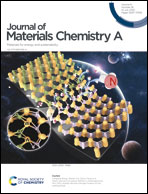Electrochemical deposition and thermoelectric characterisation of a semiconducting 2-D metal–organic framework thin film†
Abstract
The electrical conductivity and porosity of the 2-dimensional metal–organic framework Cu3(2,3,6,7,10,11-hexahydroxytriphenylene)2 [Cu3(HHTP)2] make it a promising candidate for thermoelectric applications. In this work, we report the electrochemical synthesis of Cu3(HHTP)2 films by an anodization approach and an evaluation of its thermoelectric properties. The electrochemically synthesised Cu3(HHTP)2 thin films were transferred using a wet chemical method in order to perform electrical measurements. We are reporting the first thermoelectric measurements of this framework both in bulk and thin film form which resulted in Seebeck coefficients of −7.24 μV K−1 and −121.4 μV K−1 with a power factor of 3.15 × 10−3 μW m−1 for the film respectively. The negative Seebeck coefficients suggest that Cu3(HHTP)2 behaves as an n-type semiconductor. Since the introduction of conductive MOFs in electronic devices is at an early stage of development, we believe this work validates the use of electrochemical synthetic routes of conducting MOFs to further investigate and expand their applications in thin film technologies.



 Please wait while we load your content...
Please wait while we load your content...